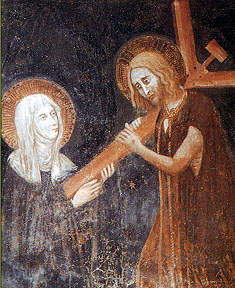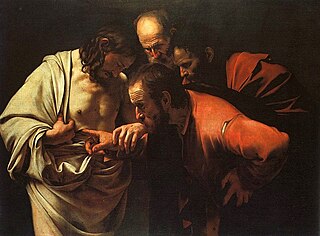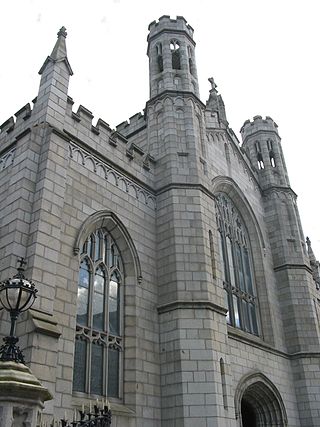
A crucifix is a cross with an image of Jesus on it, as distinct from a bare cross. The representation of Jesus himself on the cross is referred to in English as the corpus. The crucifix emphasizes Jesus' sacrifice, including his death by crucifixion, which Christians believe brought about the redemption of mankind. Most crucifixes portray Jesus on a Latin cross, rather than a Tau cross or a Coptic cross.

Kateri Tekakwitha, given the name Tekakwitha, baptized as Catherine, and informally known as Lily of the Mohawks, is a Catholic saint and virgin who was a Mohawk. Born in the Mohawk village of Ossernenon, in present-day New York State, she contracted smallpox in an epidemic; her family died and her face was scarred. She converted to Catholicism at age nineteen. She took a vow of perpetual virginity, left her village, and moved for the remaining five years of her life to the Jesuit mission village of Kahnawake, just south of Montreal. She was beatified in 1980 by Pope John Paul II and canonized by Pope Benedict XVI at Saint Peter's Basilica on 21 October 2012.

The Basilica of Sainte-Anne-de-Beaupré is a basilica set along the Saint Lawrence River in Quebec, Canada, 30 kilometres (19 mi) east of Quebec City, and one of the eight national shrines of Canada. It has been credited by the Catholic Church with many miracles of curing the sick and disabled. It is an important Catholic sanctuary, which receives about a half-million pilgrims each year. Since 1933 they have included members of the Anna Fusco Pilgrimage from Connecticut. The peak period of pilgrimage is around July 26, the feast of Saint Anne, the patron saint of sailors.

Carfin Lourdes Grotto, a Roman Catholic shrine in Scotland dedicated to Our Lady of Lourdes, was created in the early twentieth century. The "Carfin Grotto", as the shrine is locally referred to, was the brainchild of Father, later Canon Thomas N. Taylor, parish priest of St. Francis Xavier's Parish in the small, mining village of Carfin, which lies two miles east of Motherwell, in the West of Scotland. Following a trip to France's principal Marian shrine at Lourdes, Canon Taylor's vision was to build a religious memorial in honour of Our Blessed Lady based on the template of the Grotto of Massabielle. To realize this vision became his life's work. Since its opening in the early 1920s, the "grotto" has attracted pilgrims in the hundreds of thousands and its environs have been modified and enhanced with rich Catholic symbols and buildings. The grotto shrine offers a pilgrimage season with Sunday processions, rosaries, outdoor Masses and dedicated Feast Day events which run annually from early May until late September.
Thomas J. Quinlan was an American Catholic priest of the Diocese of Richmond.

Shrine of Our Lady of Guadalupe is a Catholic shrine located in La Crosse, Wisconsin. It is dedicated to the Blessed Virgin Mary under the title of Our Lady of Guadalupe. The 100-acre (0.40 km2) grounds include a visitors' center and outdoor devotional areas such as a rosary walk, Stations of the Cross, and a votive candle chapel. Mass and the sacrament of Penance are celebrated daily by Norbertine canons of St. Michael's Abbey.

The Cathedral Basilica of Saint Francis of Assisi, commonly known as Saint Francis Cathedral, is a Roman Catholic cathedral in downtown Santa Fe, New Mexico. It is the mother church of the Archdiocese of Santa Fe.

San Thome Church, officially known as St Thomas Cathedral Basilica and National Shrine of Saint Thomas, is a minor basilica of the Catholic Church in India, at the Santhome neighbourhood of Chennai, in Tamil Nadu. The present structure dates back to 1523 AD, when it was built by the Portuguese over the tomb of Thomas the Apostle. In 1896, it was renovated in the Madras province according to neo-Gothic designs, as was favoured by British architects in the late 19th century.

Clare of Montefalco, also called Saint Clare of the Cross, was an Augustinian nun and abbess. Before becoming a nun, Clare was a member of the Third Order of St. Francis (Secular). She was canonized by Pope Leo XIII on December 8, 1881. She differs from Clare of Assisi, a contemporary of St Francis and the founder of an order of Poor Clares.

The San Damiano Cross is the large Romanesque rood cross before which St. Francis of Assisi was praying when he is said to have received the commission from the Lord to rebuild the Church. It now hangs in the Basilica of Saint Clare in Assisi, Italy, with a replica in its original position in the church of San Damiano nearby. Franciscans cherish this cross as the symbol of their mission from God.

The Cathedral of St. Mary located in St. Cloud, Minnesota, United States, is the cathedral and parish church in the Catholic Diocese of St. Cloud. The St. Cloud Diocese serves Central Minnesota and a Catholic population of about 150,000.

A chaplet is a form of Christian prayer which uses prayer beads, and which is similar to but distinct from the Rosary. Some chaplets have a strong Marian element, others focus more directly on Jesus Christ and his Divine Attributes, or one of the many saints, such as the Chaplet of St Michael. Chaplets are "personal devotionals" and depending on the origins, each one of the chaplets may vary considerably. In the Roman Catholic Church, while the usual five-decade Dominican rosary is also considered to be a chaplet, the other chaplets often have fewer beads and decades than a traditional rosary and may use a different set of prayers. In the Anglican Communion, a chaplet often includes one week of the Anglican rosary.

A number of people have claimed to have had visions of Jesus Christ and personal conversations with him. Some people make similar claims regarding his mother, Mary. Discussions about the authenticity of these visions have often invited controversy. The Catholic Church endorses a fraction of these claims, and various visionaries it accepts have achieved beatification, or even sainthood.

The National Shrine of the Little Flower Basilica is a Catholic church in Royal Oak, Michigan. A designated national shrine, the church building is well-known for its execution in the lavish zig-zag Art Deco style. The structure was completed in two stages between 1931 and 1936.

The Cathedral of Saint Patrick and Saint Colman or Newry Cathedral is a Roman Catholic cathedral located in Newry, Northern Ireland. It acts as the seat of the Bishop of Dromore, and the Mother church of the Roman Catholic Diocese of Dromore. Prior to the COVID-19 pandemic, over 200,000 people visited the cathedral each year. The cathedral sits on Newry's Main Street and is a Grade A listed building.
Saint Kateri Tekakwitha Church is a Roman Catholic parish church located in Lagrangeville, Dutchess County, under the authority of the Roman Catholic Archdiocese of New York. It was established as a mission of St. Columba in Hopewell Junction in 1998 before being elevated to parish status in 2002. The church was built 2006–2008. It was "that would be a standard and model for future churches built in the Archdiocese of New York." The church was built between 2006 and 2008. Cardinal Egan among others dedicated the church on Sunday, November 23, 2008.

Sacred Heart Cathedral in Salina, Kansas, United States is the cathedral and a parish church in the Catholic Diocese of Salina. It is the second cathedral for the diocese after Our Lady of Perpetual Help in Concordia, Kansas when the See was located there.
Roland Doré was a 17th-century sculptor and his workshop or "atelier" produced many sculptures for the enclos paroissiaux or "parish church enclosure or closes" of Brittany. In particular his work can be seen on calvaries and in the church's south porch. He was born in 1616 and died in 1660. Little detail of his life is known but it is recorded that he practised as an architect in Landerneau, as well as running his workshop, and was recorded as calling himself the "Sculpteur du Roi". His works, all of an ecclesiastical nature, are mainly located in Léon and the north of Cornouaille. They can be taken as works by Doré's workshop rather than just by Doré himself. Brittany is particularly rich in calvaries, some of a very elaborate nature. In most cases the calvary involves both the crucifixion cross and side crosses or gibbets bearing the good and the bad robbers. Below this, on the crosspieces, were statues of those present at the crucifixion. A feature of Breton calvaries is that most of the statues were carved as a pair and effectively back to back. Doré's output was prodigious and he worked on nine monuments in Saint-Thégonnec, five in Logonna-Daoulas and four in the parish of Plougastel-Daoulas. He also received four commissions to work in Hanvec, three in Guiclan, Irvillac and Lampaul-Guimiliau and two commissions in Cléden-Cap-Sizun, Hôpital-Camfrout, Landerneau, La Martyre, Plabennec, Pleyben, Plogonnec, Saint-Nic, Saint-Servais and Saint-Urbain.

Saint Mary of the Assumption Catholic Church is the third oldest Catholic church building in Columbus, Ohio and is home to an active parish in the Roman Catholic Diocese of Columbus. With the rest of German Village, it was added to the National Register of Historic Places on December 30, 1974.

The Church of the Good Shepherd in Rosemont, Pennsylvania, is an Episcopal parish church in the progressive Anglo-Catholic tradition. It is part of the Episcopal Diocese of Pennsylvania and is located in the Philadelphia Main Line.


















